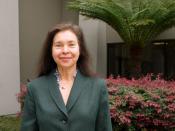
| |
| calendar |
| speakers |
| resources |
| blog |
| contact |
| Mary Barsony, Ph.D. |
Marin Science Seminar Presentation: “We Are Stardust: Genesis of the Elements” Dr. Barsony's talk focuses on how stars shine and how they have generated the elements. (February 3, 2010; March 27, 2012) Get the flyer here. One of the fundamental goals of astronomy and astrophysics is to understand how the Universe and its constituent galaxies, stars, and planets formed, how they evolved, and what their destiny will be. Dr. Barsony's research is focused on the formation of stars, brown dwarfs, free-floating planets, and planetary systems. The raw material is provided by the tenuous interstellar gas found in frigid clouds in our Galaxy. Since the present birthplaces of stars are hidden by interstellar dust mixed in with the gas, exploring the detailed mechanisms involved in star (and planetary system) formation requires observations at wavelengths whose passage is relatively unimpeded by the intervening dust: radio, millimeter, submillimeter, infrared, and X-ray wavelengths. Through submillimeter observations in the early ‘90’s, Dr. Barsony helped identify the first true protostar—an object surrounded by infalling gas that is in the process of accumulating the mass it will have as a full-fledged star. Such objects are rare, and the focus of intense current (and future) study, with space-based observatories such as the Spitzer Space Telescope, the Herschel Observatory, the planned JWST (Hubble’s replacement that wil operate at infrared wavelengths), and ALMA (the Atacama Large Millimeter/ submillimeter Array). Currently, with collaborators from Utah and Wales, she is in the midst of discovering that there may be more free floating planets than stars in our Galaxy.. Dr. Barsony is Adjunct Professor of Physics & Astronomy at San Francisco State University and a Research Scientist at the Carl Sagan Center for the Study of Life in the Universe, SETI Institute.. She earned her Ph.D. from Caltech and her S.B. from MIT. |
